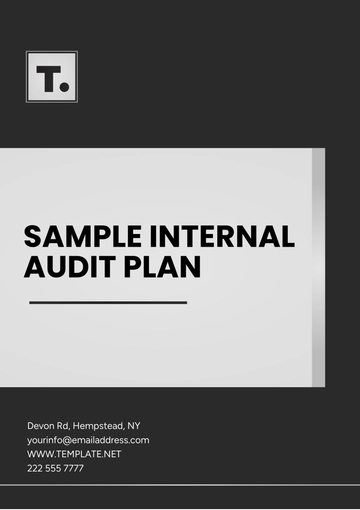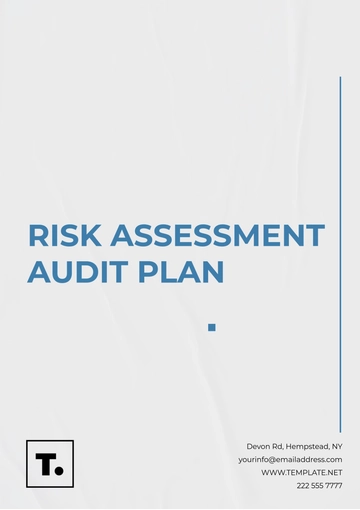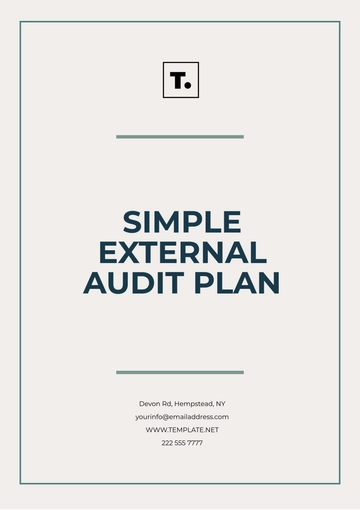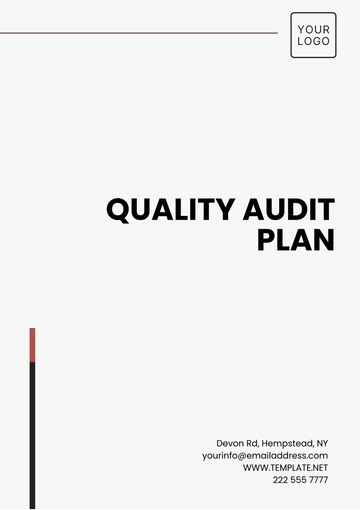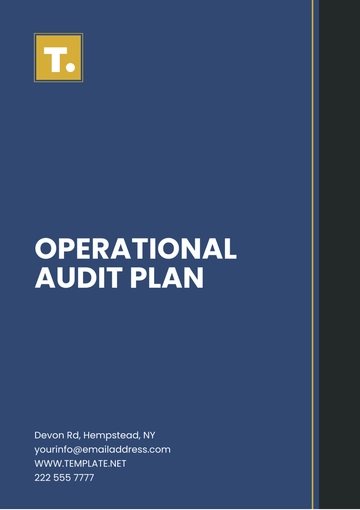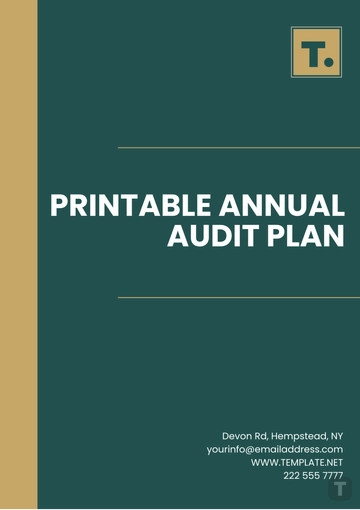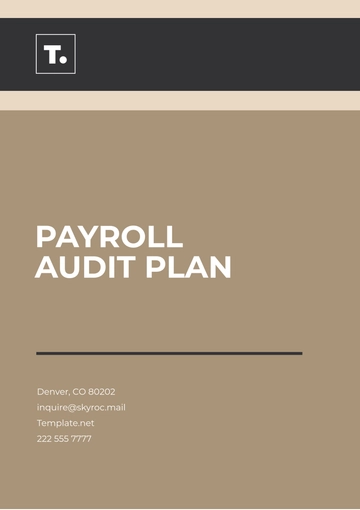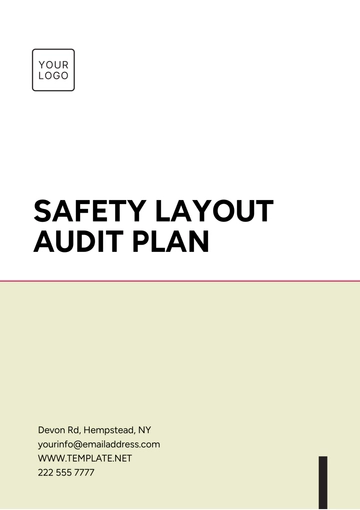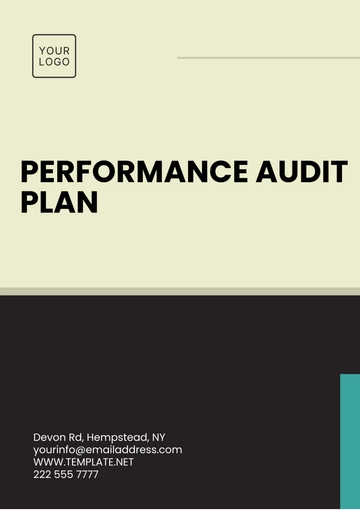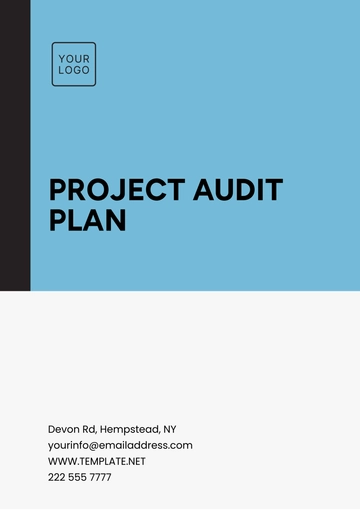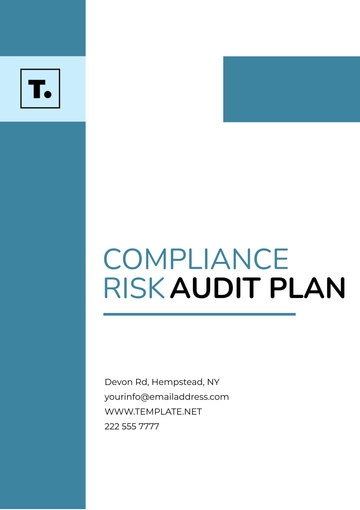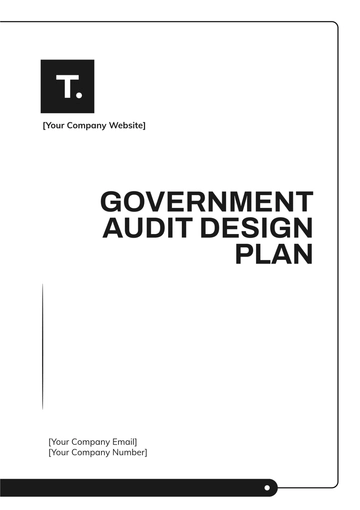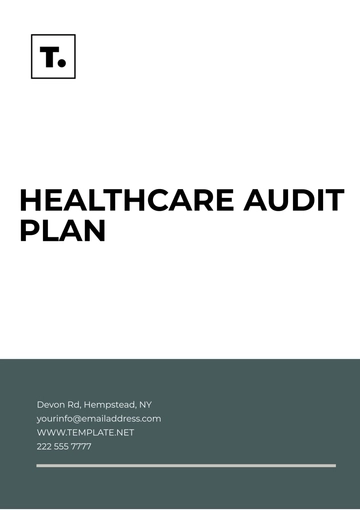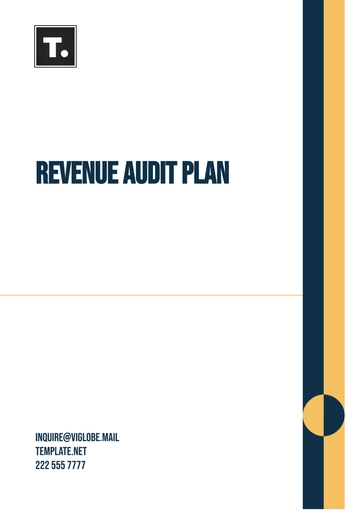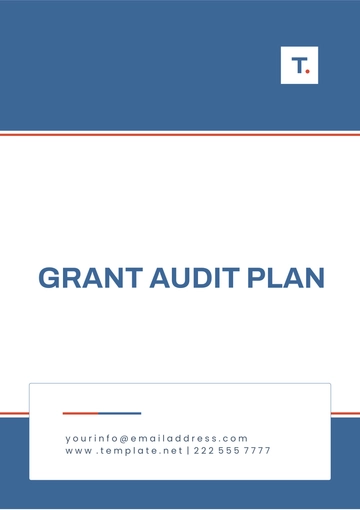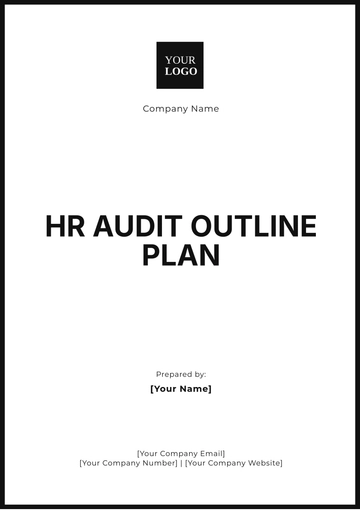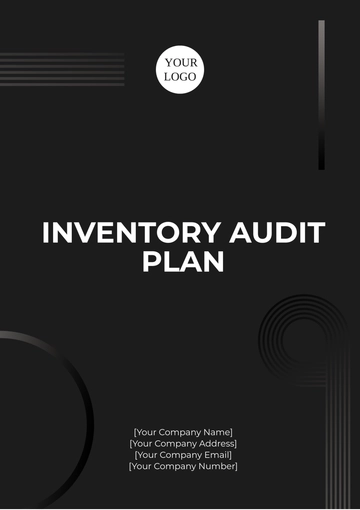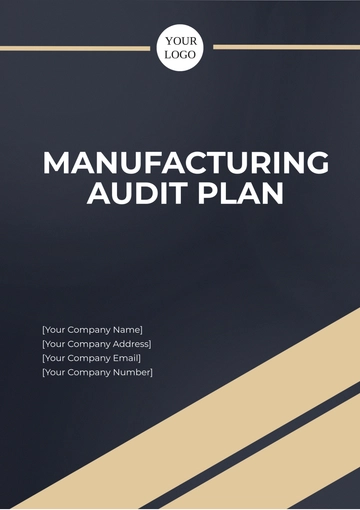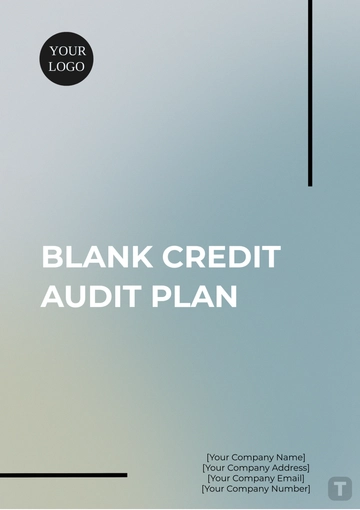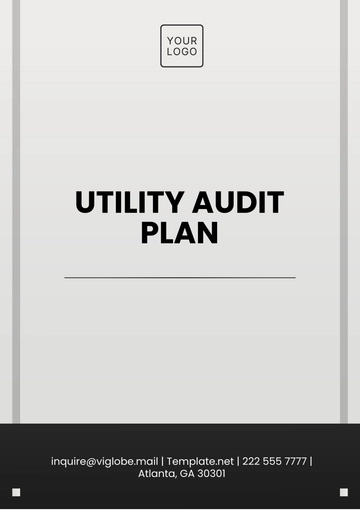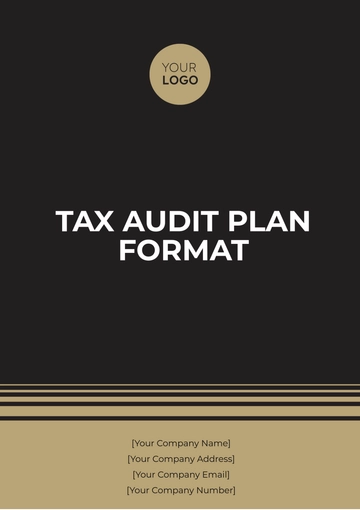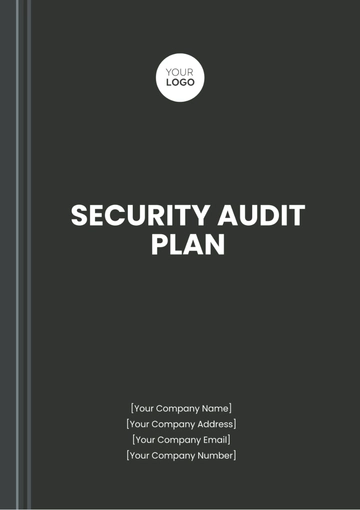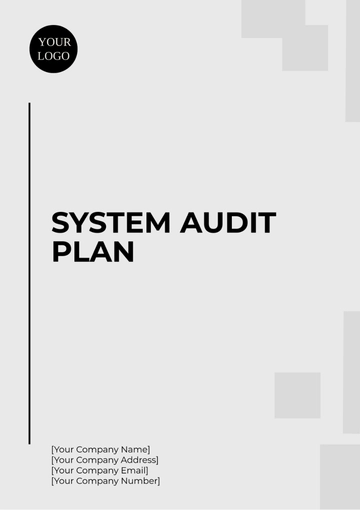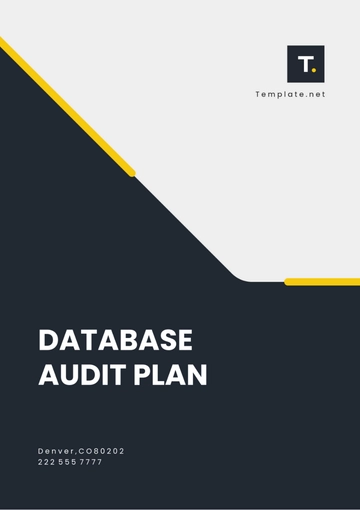Free Startup Internal Audit Plan
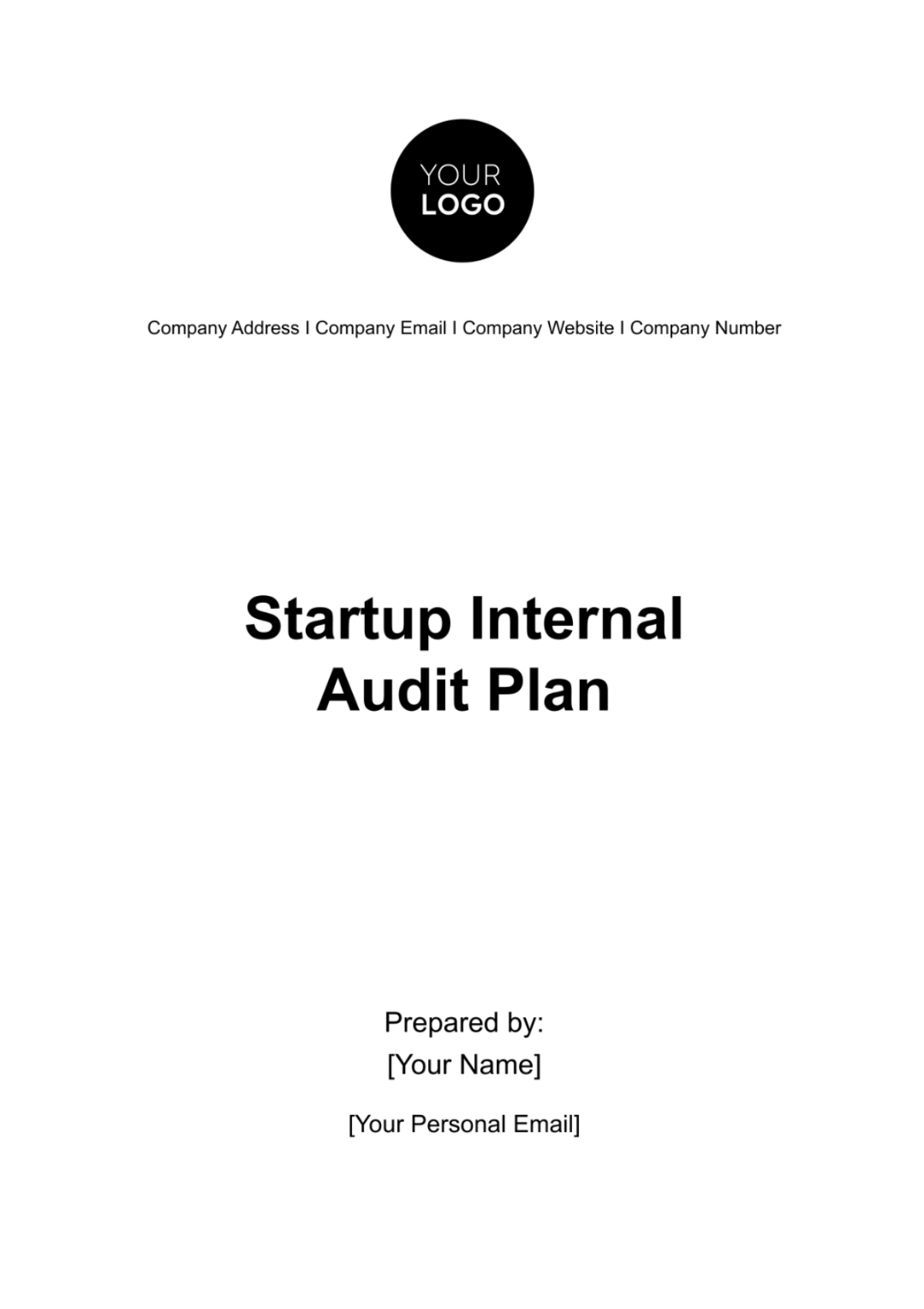
1. Introduction
The internal audit plan outlines the scope, objectives, and procedures for conducting internal audits at [Your Company Name]. This plan is designed to ensure compliance with relevant policies, procedures, and regulations, identify areas for improvement, and enhance overall operational efficiency.
2. Objectives
Evaluate the effectiveness of internal controls and risk management processes.
Ensure compliance with legal and regulatory requirements.
Identify operational inefficiencies and opportunities for process improvement.
Provide assurance to stakeholders regarding the reliability of financial reporting and data integrity.
3. Scope
The scope of the internal audit encompasses all critical aspects of [Your Company Name]'s operations, including but not limited to:
3.1 Financial Operations and Reporting:
Examination of financial transactions, accounting records, and financial statements to ensure accuracy, completeness, and compliance with accounting standards.
Evaluation of internal controls over financial reporting, including segregation of duties, authorization processes, and safeguarding of assets.
Assessment of financial risk management practices and mitigation strategies.
3.2 Compliance with Laws and Regulations:
Review of regulatory requirements applicable to [Your Company Name]'s industry, jurisdiction, and business activities.
Verification of compliance with laws, regulations, and industry standards related to taxation, licensing, data protection, environmental regulations, and employment practices.
Identification of potential legal and regulatory risks and development of mitigation plans.
3.3 Information Technology Systems and Security:
Examination of IT infrastructure, systems, and networks to assess security controls, data integrity, and protection against cyber threats.
Audit of access controls, user permissions, and data privacy measures to safeguard sensitive information.
Evaluation of disaster recovery and business continuity plans to ensure resilience against IT disruptions.
3.4 Operational Processes and Controls:
Analysis of operational workflows, procedures, and policies to identify inefficiencies, bottlenecks, and areas for streamlining.
Assessment of internal controls over operational activities, such as procurement, inventory management, production processes, and customer service.
Recommendations for process improvements, automation initiatives, and cost-saving measures to enhance operational effectiveness.
3.5 Risk Management Practices:
Identification and assessment of strategic, operational, financial, and reputational risks faced by [Your Company Name].
Review of risk management frameworks, risk appetite, and risk mitigation strategies implemented by the organization.
Recommendations for strengthening risk management processes and enhancing risk awareness throughout the organization.
3.6 Human Resources Policies and Procedures:
Examination of HR policies, practices, and procedures to ensure compliance with employment laws and regulations.
Audit of employee hiring, onboarding, performance management, and termination processes to promote fairness, equity, and adherence to company values.
Assessment of employee training and development initiatives to support talent retention and organizational growth.
4. Audit Procedures
4.1 Planning Phase
During the planning phase, the internal audit team meticulously lays the groundwork for the audit process, ensuring thorough preparation and alignment with organizational objectives. This phase involves:
Defining clear audit objectives, scope, and timelines to guide the audit activities effectively.
Conducting a comprehensive risk assessment to identify key areas of focus and prioritize audit efforts.
Engaging stakeholders and obtaining management buy-in to ensure support and cooperation throughout the audit process.
Allocating resources, including personnel, time, and budget, in accordance with the audit plan and requirements.
Developing a detailed audit plan outlining specific audit procedures, methodologies, and responsibilities for each team member.
4.2 Fieldwork Phase
The fieldwork phase is the heart of the audit process, where the internal audit team conducts in-depth examinations and gathers evidence to assess controls, identify risks, and evaluate compliance. This phase involves:
Conducting interviews with key personnel to gain insights into business processes, controls, and potential areas of concern.
Performing detailed testing procedures, including sample testing, data analysis, and documentation review, to validate the effectiveness of internal controls.
Examining supporting documentation, such as invoices, contracts, and financial records, to ensure accuracy, completeness, and compliance with policies and regulations.
Observing operational activities and processes firsthand to identify any deviations from established procedures or best practices.
Documenting audit findings, observations, and evidence in a clear and organized manner to support the audit conclusions and recommendations.
4.3 Reporting Phase
In the reporting phase, the internal audit team synthesizes the findings from the fieldwork and communicates them effectively to stakeholders, management, and relevant oversight bodies. This phase involves:
Analyzing audit results to identify trends, patterns, and areas of strength or weakness within the organization.
Preparing comprehensive audit reports that clearly articulate the audit objectives, scope, methodology, findings, conclusions, and recommendations.
Presenting audit findings to management and key stakeholders in a transparent and objective manner, facilitating open dialogue and feedback.
Collaborating with management to develop action plans and remediation strategies to address identified deficiencies and improve internal controls.
Monitoring the implementation of corrective actions and follow-up on outstanding audit issues to ensure timely resolution and accountability.
5. Audit Schedule
Audit Area | Planning Phase | Fieldwork Phase | Reporting Phase |
|---|---|---|---|
Financial Operations | Feb 1 - Feb 5, 2023 | Feb 8 - Feb 19, 2023 | Feb 22 - Feb 26, 2023 |
IT Systems and Security | Mar 1 - Mar 5, 2023 | Mar 8 - Mar 19, 2023 | Mar 22 - Mar 26, 2023 |
Operational Processes | Apr 5 - Apr 9, 2023 | Apr 12 - Apr 23, 2023 | Apr 26 - Apr 30, 2023 |
Compliance with Laws and Regulations | May 3 - May 7, 2023 | May 10 - May 21, 2023 | May 24 - May 28, 2023 |
Human Resources Policies and Procedures | Jun 7 - Jun 11, 2023 | Jun 14 - Jun 25, 2023 | Jun 28 - Jul 2, 2023 |
6. Roles and Responsibilities
The successful execution of the internal audit plan relies on the clear delineation of roles and responsibilities among key stakeholders. Each role plays a crucial part in ensuring the effectiveness and integrity of the audit process.
6.1 Audit Committee:
The Audit Committee is responsible for providing oversight and guidance on the internal audit activities. Their roles and responsibilities include:
Reviewing and approving the audit plan, including the scope, objectives, and resource allocation.
Monitoring the progress of audit activities and ensuring compliance with established policies and procedures.
Reviewing audit reports and findings, providing feedback, and ensuring appropriate follow-up on identified issues.
Engaging with external auditors, regulatory bodies, and other stakeholders as necessary to fulfill their oversight duties.
6.2 Internal Audit Team:
The Internal Audit Team is responsible for conducting the internal audits in accordance with the approved audit plan. Their roles and responsibilities include:
Planning and executing audit procedures to assess the adequacy and effectiveness of internal controls.
Gathering evidence, conducting interviews, and performing testing procedures to validate audit findings.
Documenting audit workpapers, observations, and recommendations in accordance with professional standards and organizational policies.
Communicating audit results to management, stakeholders, and the Audit Committee in a clear, concise, and timely manner.
Collaborating with management to develop action plans and recommendations for addressing identified deficiencies and improving internal controls.
6.3 Management:
Management plays a critical role in supporting the internal audit process and implementing audit recommendations. Their roles and responsibilities include:
Providing access to relevant records, systems, and personnel to facilitate the audit process.
Reviewing and responding to audit findings, including implementing corrective actions and remediation plans.
Monitoring the progress of corrective actions and ensuring timely resolution of identified deficiencies.
Fostering a culture of accountability, transparency, and continuous improvement throughout the organization.
Engaging with the Audit Committee and internal audit team to address any concerns or questions related to audit activities.
6.4 Stakeholders:
Stakeholders, including employees, customers, suppliers, and investors, also play a role in the internal audit process. Their roles and responsibilities include:
Cooperating with the internal audit team by providing information, feedback, and support as needed.
Reviewing audit reports and findings relevant to their areas of responsibility or interest.
Participating in follow-up activities and contributing to the implementation of audit recommendations where applicable.
Providing input and feedback on the effectiveness of internal controls, risk management practices, and overall governance processes.
By clearly defining and aligning the roles and responsibilities of key stakeholders, [Your Company Name] aims to foster collaboration, accountability, and transparency in the internal audit process, ultimately enhancing organizational performance and integrity.
7. Monitoring and Review
7.1 Key Performance Indicators (KPIs):
Establishing key performance indicators (KPIs) allows [Your Company Name] to measure the performance and effectiveness of the internal audit function. Some common KPIs include:
Audit completion rate: Percentage of planned audits completed within the scheduled timeframe.
Audit coverage: The extent to which all key risk areas are addressed through the audit plan.
Timeliness of reporting: Average time taken to issue audit reports and communicate findings to stakeholders.
Implementation of recommendations: Percentage of audit recommendations implemented by management within the agreed-upon timeline.
Stakeholder satisfaction: Feedback from stakeholders on the quality, relevance, and usefulness of audit reports and recommendations.
7.2 Continuous Improvement Initiatives:
[Your Company Name] is committed to fostering a culture of continuous improvement within the internal audit function. This involves:
Conducting periodic reviews and evaluations of audit processes, methodologies, and tools to identify opportunities for enhancement.
Soliciting feedback from stakeholders, including management, Audit Committee members, and internal audit team members, to assess the effectiveness of audit activities and identify areas for improvement.
Implementing best practices and lessons learned from past audits to optimize future audit engagements and enhance efficiency and effectiveness.
Investing in training and development opportunities for internal audit team members to ensure they have the necessary skills and knowledge to perform their roles effectively and stay abreast of emerging trends and developments in the field of internal auditing.
7.3 Stakeholder Engagement:
Regular engagement with stakeholders is essential for maintaining transparency, accountability, and trust in the internal audit process. This involves:
Communicating audit plans, objectives, and findings to relevant stakeholders in a clear, timely, and transparent manner.
Soliciting feedback and input from stakeholders on the audit process, including their perceptions of audit effectiveness, relevance, and value-added.
Engaging with stakeholders to address any concerns or questions related to audit activities, findings, or recommendations.
Providing regular updates and reports to the Audit Committee and senior management on the status and progress of audit activities, including any significant findings or emerging risks.
7.4 Periodic Review and Reporting:
Regular review and reporting on the internal audit function's performance and activities are critical for accountability and oversight. This involves:
Conducting periodic reviews and assessments of the internal audit function's performance against established goals, objectives, and KPIs.
Preparing and presenting reports to the Audit Committee and senior management summarizing audit activities, findings, and recommendations.
Providing insights and analysis on trends, patterns, and emerging risks identified through the audit process.
Documenting lessons learned and best practices from past audits to inform future audit planning and execution.
8. Conclusion
The internal audit plan serves as a roadmap for conducting comprehensive audits to evaluate the effectiveness of internal controls, identify areas for improvement, and enhance overall organizational performance. By adhering to this plan, [Your Company Name] aims to ensure transparency, accountability, and continuous improvement in its operations.
- 100% Customizable, free editor
- Access 1 Million+ Templates, photo’s & graphics
- Download or share as a template
- Click and replace photos, graphics, text, backgrounds
- Resize, crop, AI write & more
- Access advanced editor
Strengthen your startup's internal controls with Template.net's Startup Internal Audit Plan Template—an essential tool for ensuring compliance and operational efficiency. This editable and customizable template, available using our AI Editor Tool, empowers you to outline audit objectives, scope, methodologies, and timelines comprehensively. Enhance accountability and risk management with this professionally crafted plan!
You may also like
- Finance Plan
- Construction Plan
- Sales Plan
- Development Plan
- Career Plan
- Budget Plan
- HR Plan
- Education Plan
- Transition Plan
- Work Plan
- Training Plan
- Communication Plan
- Operation Plan
- Health And Safety Plan
- Strategy Plan
- Professional Development Plan
- Advertising Plan
- Risk Management Plan
- Restaurant Plan
- School Plan
- Nursing Home Patient Care Plan
- Nursing Care Plan
- Plan Event
- Startup Plan
- Social Media Plan
- Staffing Plan
- Annual Plan
- Content Plan
- Payment Plan
- Implementation Plan
- Hotel Plan
- Workout Plan
- Accounting Plan
- Campaign Plan
- Essay Plan
- 30 60 90 Day Plan
- Research Plan
- Recruitment Plan
- 90 Day Plan
- Quarterly Plan
- Emergency Plan
- 5 Year Plan
- Gym Plan
- Personal Plan
- IT and Software Plan
- Treatment Plan
- Real Estate Plan
- Law Firm Plan
- Healthcare Plan
- Improvement Plan
- Media Plan
- 5 Year Business Plan
- Learning Plan
- Marketing Campaign Plan
- Travel Agency Plan
- Cleaning Services Plan
- Interior Design Plan
- Performance Plan
- PR Plan
- Birth Plan
- Life Plan
- SEO Plan
- Disaster Recovery Plan
- Continuity Plan
- Launch Plan
- Legal Plan
- Behavior Plan
- Performance Improvement Plan
- Salon Plan
- Security Plan
- Security Management Plan
- Employee Development Plan
- Quality Plan
- Service Improvement Plan
- Growth Plan
- Incident Response Plan
- Basketball Plan
- Emergency Action Plan
- Product Launch Plan
- Spa Plan
- Employee Training Plan
- Data Analysis Plan
- Employee Action Plan
- Territory Plan
- Audit Plan
- Classroom Plan
- Activity Plan
- Parenting Plan
- Care Plan
- Project Execution Plan
- Exercise Plan
- Internship Plan
- Software Development Plan
- Continuous Improvement Plan
- Leave Plan
- 90 Day Sales Plan
- Advertising Agency Plan
- Employee Transition Plan
- Smart Action Plan
- Workplace Safety Plan
- Behavior Change Plan
- Contingency Plan
- Continuity of Operations Plan
- Health Plan
- Quality Control Plan
- Self Plan
- Sports Development Plan
- Change Management Plan
- Ecommerce Plan
- Personal Financial Plan
- Process Improvement Plan
- 30-60-90 Day Sales Plan
- Crisis Management Plan
- Engagement Plan
- Execution Plan
- Pandemic Plan
- Quality Assurance Plan
- Service Continuity Plan
- Agile Project Plan
- Fundraising Plan
- Job Transition Plan
- Asset Maintenance Plan
- Maintenance Plan
- Software Test Plan
- Staff Training and Development Plan
- 3 Year Plan
- Brand Activation Plan
- Release Plan
- Resource Plan
- Risk Mitigation Plan
- Teacher Plan
- 30 60 90 Day Plan for New Manager
- Food Safety Plan
- Food Truck Plan
- Hiring Plan
- Quality Management Plan
- Wellness Plan
- Behavior Intervention Plan
- Bonus Plan
- Investment Plan
- Maternity Leave Plan
- Pandemic Response Plan
- Succession Planning
- Coaching Plan
- Configuration Management Plan
- Remote Work Plan
- Self Care Plan
- Teaching Plan
- 100-Day Plan
- HACCP Plan
- Student Plan
- Sustainability Plan
- 30 60 90 Day Plan for Interview
- Access Plan
- Site Specific Safety Plan


